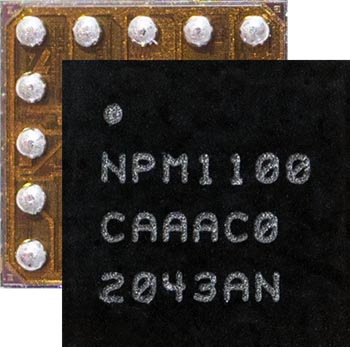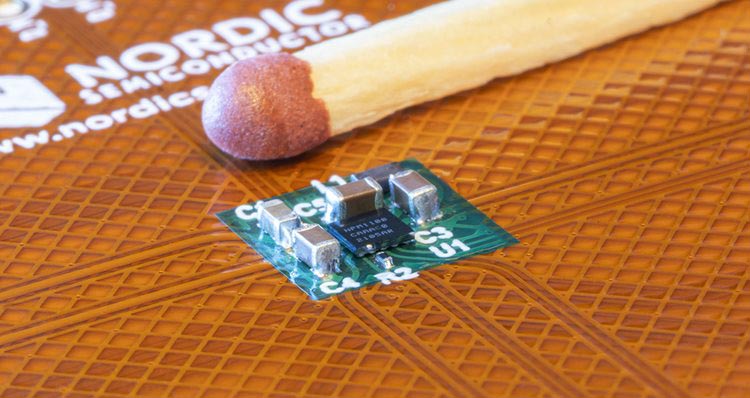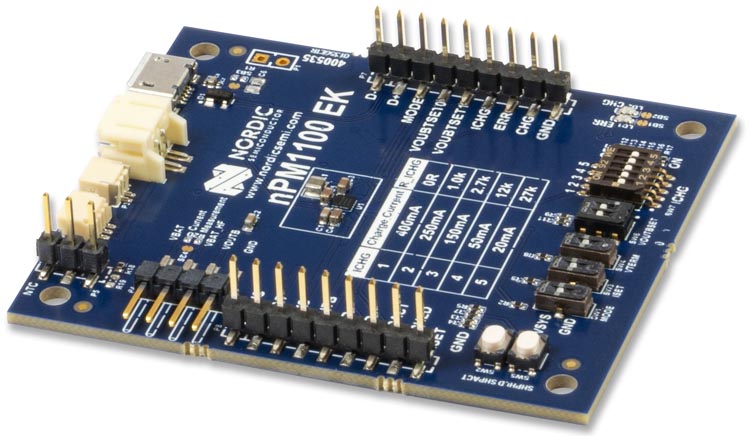nPM1100 PMIC is Nordic’s first power management product and combines a USB compatible Li-ion/Li-Po battery charger and highly efficient DC/DC buck regulator in a compact WLCSP package for space-constrained applications
Nordic Semiconductor announces the launch of its first power management IC (PMIC), the ‘nPM1100’. The nPM1100 combines a USB compatible input regulator with overvoltage protection, 400 mA battery charger and 150 mA DC/DC step-down (“buck”) voltage regulator in a 2.075 × 2.075 mm wafer level chip scale package (WLCSP). The PMIC ensures reliable power supply and stable operation for Nordic’s nRF52® and nRF53® Series multiprotocol Systems-on-Chip (SoCs) and maximizes application battery life. The product can also be used as a generic PMIC for any application using rechargeable Lithium Ion or Lithium Polymer batteries. Its extremely compact form factor makes it ideal for advanced wearables, connected medical devices, and other space-constrained applications.

Bluetooth® Low Energy (Bluetooth LE) applications based on nRF52 and nRF53 Series SoCs and using rechargeable Li-ion/Li-Po batteries can take advantage of the nPM1100’s battery charger to bypass the first regulator stage of the SoCs. In addition, when used in this configuration the high efficiency of the nPM1100’s buck regulator reduces overall system power consumption while its 150 mA current capability increases the current available for other system components from approximately 10 mA to 100 mA.

Ultra low quiescent current
The nPM1100 features an ultra low quiescent current (IQ) of 700 nA (typ.) which can be further reduced to 470 nA in “ship mode”. Ship mode also disables power output – removing the need for an external power switch and ensuring minimum battery lifetime impact on products in transit. The power management solution takes up as little as 23 mm2 of PCB area, including passive components (rising to 27 mm2 when optimized for performance) - much less than comparable competitive products.
The nPM1100 input regulator draws its power from either a 4.1 to 6.6 V USB input or from a 2.3 to 4.35 V connected battery input; it can supply a 3.0 to 5.5 V unregulated voltage to the application at up to 500 mA output current. The PMIC supports USB Standard Downstream Port (SDP), Charging Downstream Port (CDP) and Dedicated Charger Port (DCP) detection. The input regulator includes overvoltage protection for transient voltage spikes up to 20 V.
The PMIC’s JEITA-compliant battery charger will charge the application’s Li-ion/Li-Po battery with a resistor-selectable charge current from 20 to 400 mA and a selectable termination voltage of 4.1 or 4.2 V. The charger includes battery thermal protection and automatic selection from three charging modes: Automatic trickle, constant current and constant voltage. The charger also features a discharge current limitation.
High efficiency voltage regulator
The product’s highly efficient DC/DC buck voltage regulator runs at more than 90 percent efficiency down to below 100 µA load current. It takes its power from the input system regulator and provides up to 150 mA current at a selectable 1.8, 2.0, 2.7 or 3.0 V regulated output voltage. The regulator features soft startup and automatic transition between hysteretic and pulse width modulation (PWM) modes. It also supports a forced PWM mode to ensure the cleanest power operation possible.
The nPM1100 requires no configuration software to operate as all settings are pin configurable. The PMIC is compatible with all devices designed to operate within the output voltages and supply currents the chip can deliver. The product’s operating temperature range is –40 to 85 °C.
Evaluation kit
The new PMIC is accompanied by the ‘nPM1100 Evaluation Kit’. The Evaluation Kit (EK) features switches for all selectable settings, buttons to enter and exit ship mode and connectors for batteries, USB and headers for all pins on the PMIC. The headers allow for overriding switches if SW control of configuration is required. The EK allows for testing of the nPM1100 PMIC’s capabilities with existing applications without the need for creating custom hardware. The EK can be powered by USB via the on-board micro-USB port, from an external DC power supply through header pins or from battery power via the battery connectors on one of the headers. The EK is designed for use with other Nordic Development Kits (DKs) or to test out the PMIC’s functionality with non-Nordic products.
 |
| The nPM1100 Evaluation Kit. |
The nPM1100 is in volume production and samples are available now.